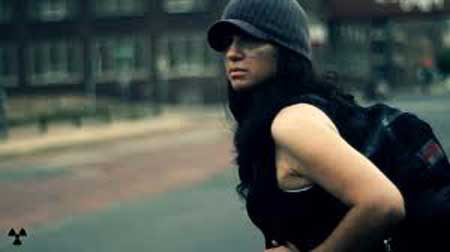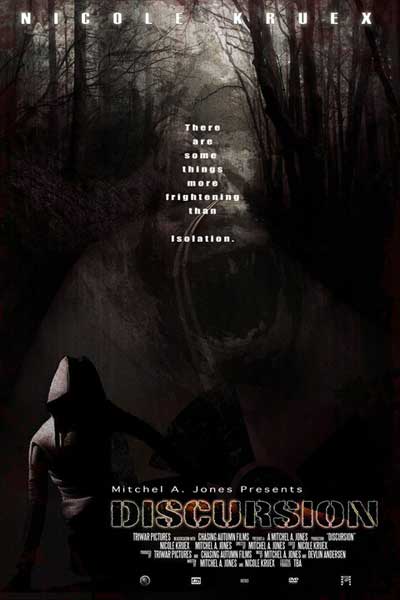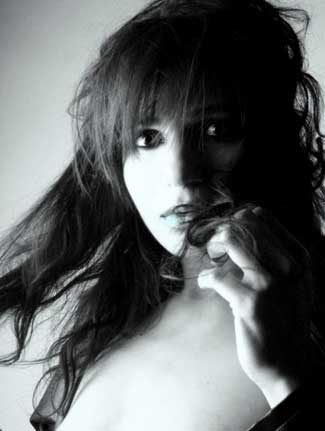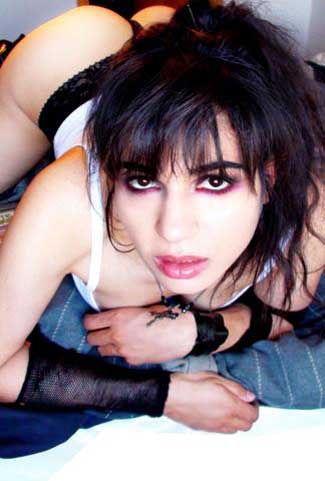 Welcome my very special guests at this time Ms. Nicole Kruex and Mr. Mitchel A. Jones to Horrornews.net. I wish to extend my congratulations on such a superb film as After The Dawn. Fans may not realize the two of you co-wrote the original story. Describe the brainchild on how this tale was conceived.
Welcome my very special guests at this time Ms. Nicole Kruex and Mr. Mitchel A. Jones to Horrornews.net. I wish to extend my congratulations on such a superb film as After The Dawn. Fans may not realize the two of you co-wrote the original story. Describe the brainchild on how this tale was conceived.
NICOLE KRUEX: Well in all honesty we were digging through a whole lot of Lion’s Gate releases, in the lower budget range. To be quite honest our initial reaction was that we could do better than that with our hands tied behind our backs (combined laughs). So we decided why don’t we try to shoot something and see what happens. We went on our standard let’s just hook up an Indy go-go thing and see if we had enough to cover our special effects which was roughly fifteen hundred dollars. Roughly seventy two hours later we had fifteen thousand which surprised us. At that point we realized ‘oh crap now we have to shoot a real movie.’ So in about two weeks we conceived a rough outline of the original story. We took it and turned it into a full on script. From there on out it’s kind of history.
But to be honest the script itself is nothing like the original movie.
MITCHEL A JONES: Yeah the movie is completely rearranged from the original story. Basically we were confined to lack of money and though oh yeah we can just rework this in post but actually I think it lead to the story being more dynamic as it is.
NK: True story.
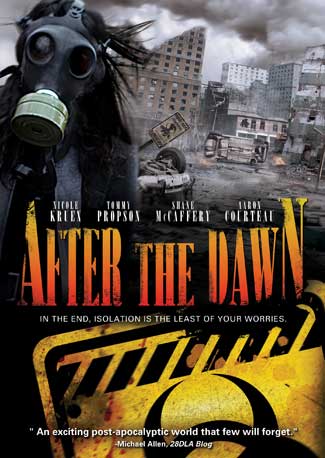 HN: I think it’s a testament to the fact that not necessarily a whole lot of special effects and certainly a lot of trends are developing towards a good psychological thriller doesn’t constitute a lot of blood and gore. It’s encouraging to see.
HN: I think it’s a testament to the fact that not necessarily a whole lot of special effects and certainly a lot of trends are developing towards a good psychological thriller doesn’t constitute a lot of blood and gore. It’s encouraging to see.
How does After The Dawn differ from other post-apocalyptic films?
NK: I think first and foremost you touched on it right there. We didn’t intend to go out there and make this a zombie movie. I think that, that is one thing people don’t get from the trailer. It looks like Twenty Eight Days Later or a film concentrating on zombies or how they’re infected. That’s not wasn’t our goal. Our goal was to tell the back story of the main character and how’d she’d come to be where she was at and what her reality is, which obviously I’m not going to give away because it’s kind of the crust of the movie. But if we’d taken a different approach from a different area…
MJ: We knew getting into this we wouldn’t be able to compete with heavy special effects, blood and gore, we knew that was out of the question because it would just come off really cheesy. We thought why not get back to what we love about horror which is essentially the seventies and early eighties, let’s just tell a story. The horror really is just the entire situation. It’s not just a bunch of gag scares here and there. The story, you know I think is the whole horror element.
HN: I think it opens up a whole lot more to the imagination and to the perception of the audience too. I think that often times what makes for effective horror is what we don’t see or perhaps what the camera is eluding to as a possibility. It makes for an intriguing conversational piece, resonating with you long after the fact. It’s very sound film making.
MJ: The thing is, the audience isn’t stupid. And a lot of films today spell everything out for you. There’s no suspense, no nothing. They’re just thrown at you. We talk about Shyamalan and stuff where sound design is such a huge part. What you don’t see is often more scary than what you do see. We wanted to play towards that.
HN: Excellent. Versatility was certainly the vocation of the hour as Nicole you’d not only co-written but co-produced, starred and edited the final product where Mitchel you had adapted cinematography elements, directing and co-producing. What were some of the biggest challenges or obstacles when shooting?
NK: Schedules and money! One of our biggest problems came down to shooting with a child. We love Tommy. He’s a brilliant little boy. But when you’re talking twelve years old and in school and you have every sport…
MJ: …..every sport you can imagine. So when it’s not practice we only had a maximum of three hours at a time.
NK: Technically he was supposed to be in the movie I’d say twenty percent more than what he is. We had to edit him out because of his schedule. We would have him from six to eight on a Thursday and then wait a week until we got him again. So that was probably the biggest challenge and that ended up changing the script which I guess at this point may have been a good thing.
MJ: Yeah I think we had to adapt and that’s just film making and problem solving in general. I think that made the story a little bit stronger because we did cut a lot, maybe twenty minutes out of the movie. Honestly…
NK: …the original cut was maybe an hour and forty two minutes.
MJ: ….yeah and the other restrictions I mean not having a crew. We shot right in the snow and I’d literally have the camera on my shoulder and be directing and have the sound on the other shoulder. We’d be like using rubber bands to put the boom mike on the camera and it was just ridiculously difficult with such limited resources and people.
NK: Yeah I think time and money is what caused us the two biggest problems. But we persevered.
HN: Oh absolutely. There are some effective scenes such as in the grocery store, the coffee shop, the movie theatre sequences come to mind just to name a few. They’re chilling, eerie and personify a sense of surrealism and unease. Mitchel, what techniques are used to convey effective cinematography without extravagant degrees of special effects, blood and gore.
MJ: Well going into the shoot you look at flashbacks which is standard story telling. Almost when you’re following Nicole’s journey we had almost a voyeuristic type feel. The camera really takes on a certain character moving with her, walking through all of these events. When we’d gotten to the scenes in which you’d mentioned we kind of walked with the camera off more and just played with different styles and perceptions I guess to get a feel of unease. We definitely want to change up the camera style intentionally to make the film look broken up and chopped up. I think that helps.
NK: I think that the entire film in itself went from a lot of day time lighter shots and then as you got through the film things got darker and darker. It was almost a foreboding by the time you got to the end of it.
MJ: Yeah we really played with it in post with just color. We started pulling color out just very slowly so by the end of the film you get flash backs that are just drab and grey. Then you get the whole world just loose life to it. We really wanted to get just a psychological feeling that you may not necessarily pick up on but it takes on a darker feel by the end.
HN: There’s a real sense of evolutionary progression. It’s done with such finesse and such subtlety that I think it will prey upon the psyche of fans for some time to come. Without disclosing any plot spoilers, it is evident there are some prominent influences behind the creative mind. As fans of horror and dark fantasy who are some of your notable influences?
NK: Mine’s Alfred Hitchcock, a big one for me. I like the unseen. Just as far as storytelling and cinematography stuff goes I like Hollywood. I like Spielberg and oh I don’t know….
MJ: ….definitely Kubrick…..
NK: ….oh yes Kubrick.
MJ: Shyamalan like we’d discussed with sound design. Signs was a huge influence.
NK: Scorsese.
MJ: Scorsese. We just love movies.
NK: Movies are pretty awesome (combined laughs).
HN: I couldn’t agree more, an excellent escape. I couldn’t agree more. Music is a key element in any production that can without doubt enhance or on the other end of the spectrum distract from the plot. Devlin Andersen is an absolute enigma and seems like a perfect match for this project. Describe his involvement and how it evolved with After The Dawn.
NK: Devlin’s been a friend of mine for quite a few years and he has his own company called Dead Sound. He’s a very industrial, techno-ish kind of dark wave, electronic kind of musician. I think I saw somewhere someone had likened his style to a kind of Nine Inch Nails feel and that describes him exactly. And to be honest we did two things. We had Devlin come in and score the way he would then we went back after the fact and added some more foreboding and some more and tipped off some of the elements, wrapped some more drama into it. His work combined with what we brought in, it just really helped tell the story.
MJ: It took it to a whole new level and knowing Dev going in we knew early on that we were going to use him so we were setting up shots with his style in mind. We knew what was going to work and what wasn’t going to work just based on his music. That also swayed on the edits. How long we would have on something. It was very collaborative from early on and throughout the entire project.
HN: I have to be honest when I’d screened the film I’d watched it on my lap top with my head phones and as soon as the credits hit and that first note I actually jumped and thought something was wrong with my sound. But it makes for some very creative mood.
NK & MJ: (combined laughs)
MJ: That’s cool. That’s awesome.
HN: What’s on the horizon for Mitchel Jones and Nicole Kruex?
NK: Oh I don’t think we’re allowed to say quite yet but we’re working on the next film. I would expect you can hear something about it in two , three months. And then we’ve got probably two more coming and then hopefully a television show for horror channel TV.
MJ: Lots of stuff.
NK: Lots of stuff in the near future. We slowly trying to build up our resume I guess.
MJ: One of the pushing factors behind After The Dawn we wanted to not only just get out there and say hey we can get out there and do this. We want to do this. We want to take that first step in getting out there and opening new doors. And that’s what it’s actually done for us.
NK: And honestly there’s two people involved in are hugely instrumental that are film mentors/guides one of them our executive producer Jordan Levine and another executive producer we have Shelby Dillon. Those people have been paramount in helping us move forward. We didn’t expect any of this to happen frankly. We shot the movie with the intent of picking up a thousand copies and selling it out of a back of a van hoping to make our money back and now it’s turned to worldwide distribution where possibly it’ll be placed in a Wal-Mart and Target and stuff so we’re kind of floored. We’re humbled by the whole experience.
MJ: Excited…
NK: …exited by the whole experience. We’re learning a lot, a whole heck of a lot. It’s been interesting.
It’s being distributed through Entertainment Seven internationally. Domestically it’s Midnight Releasing.
HN: When is it available for fans to purchase?
NK: September 25th it will be available through video on demand and purchase I’m assuming closely after that.
We don’t have an exact release date but you’ll be able to get it on Netflicks and that sort of thing.
HN: Anything you’d care to add or a special message to your fans as well?
NK: I think most of all we need to thank our cast and crew.
MJ: Everybody.
NK: They made the film happen. We were just there to create the idea but without them it wouldn’t be all that it is.
HN: It’s been a lot of fun, entertaining and enlightening.
NK: Thank you and we look forward to seeing it. And you specifically thank you so much. You’ve been more than kind and absolutely incredible.
MJ: Yes thank you so much we really appreciate it.
HN: Thanks again and all the best with After The Dawn and your future endeavors.
Interview: Nicole Kruex | Mitchel A Jones (After The Dawn)
 Horror News | HNN Official Site | Horror Movies,Trailers, Reviews
Horror News | HNN Official Site | Horror Movies,Trailers, Reviews

